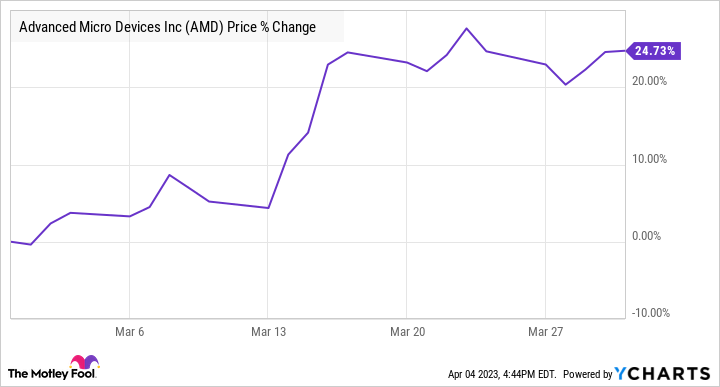What happened
Shares of Advanced Micro Devices (AMD -0.71%) were moving higher last month as the chipmaker benefited from analyst upgrades, a perception that the downturn in the semiconductor industry would end sooner than expected, and a favorable response to earnings from Micron at the end of the month, though the memory chipmaker continues to struggle.
According to S&P Global Market Intelligence, the stock finished the month up 25%. As you can see from the chart below, the bulk of those gains came in the middle of the month as tech stocks rose after Silicon Valley Bank collapsed and investors bid up the chip sector as a whole.
AMD data by YCharts.
So what
AMD got the month started on the right foot after Raymond James resumed coverage of the chip stock with a strong buy rating, saying it was an “underappreciated artificial intelligence and machine learning play” and that its combination of CPU, GPU, and FPGA chips make it well positioned for the AI/ML market.
The following day, CNBC reported that Dan Loeb’s Third Point hedge fund took a passive stake in the company.
The stock then surged in the third week of the year on hopes that the Federal Reserve would take a pause from interest rate hikes in the FOMC meeting the following week. One well-followed analyst, Christopher Rolland, said that the consumer electronics sector had likely already bottomed, a bullish forecast for AMD as a significant portion of its business comes from PCs.
Finally, chip stocks got a boost at the end of the month after investors responded well to Micron’s earnings report, even as the memory chip maker reported declines in both revenue and earnings as investors had interpreted the report as the chip market hitting bottom.
Wells Fargo also raised its price target on AMD from $85 to $120, reaffirming its overweight rating, and said it’s increasing its estimates for next year’s results to reflect a growing addressable market in its data center business.
Now what
With last month’s recovery, AMD stock is already up roughly 75% from its bottom last October, indicating investors already seem to be pricing in a recovery.
While revenue is expected to be flat this year, investors expect a return to growth, and AMD is still modestly priced at a price-to-earnings ratio of 22 based on 2024 estimates.
Given the company’s track record and competitive advantages, AMD still looks like a good bet to outperform over the long run, despite the current industry headwinds.
